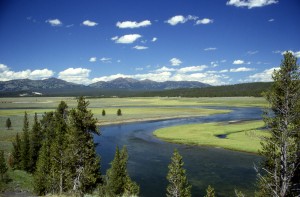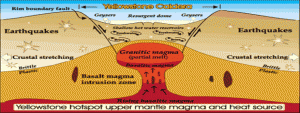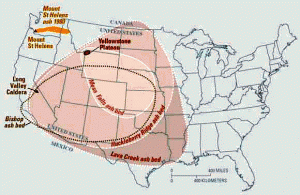So what happens if and when the Yellowstone Caldera pops its top? I got curious and dug in to do a little research. There is no doubt that volcanic explosions in the past have had not just a local, but also a global wide detrimental effect. Some of the more notable explosions in recorded history have led to massive drops in temperatures, or mini global ice ages, as recent as the early 1700 and 1800s. As you read you will see a lot of words like possible, likely, could happen, and such. This is because everything about the future is theory.
“The Yellowstone Caldera is the volcanic caldera and super volcano located in Yellowstone National Park in the United States, sometimes referred to as the Yellowstone Super volcano. The caldera is located in the northwest corner of Wyoming, in which the vast majority of the park is contained. The major features of the caldera measure about 34 by 45 miles (55 by 72 km). The caldera formed during the last of three super eruptions over the past 2.1 million years.”
I choose Yellowstone today because it is right on our doorstep, and one of the few super volcanoes on the earth that could affect every single person if it were to go…in theory. Based on geological records experts have put a rough 1 in 10,000 chance of a super-eruption of Yellowstone during our lifetimes. But considering the erratic behavior of volcanoes, that number means next to nothing. The buried magma might never erupt again, or it might give us the fireworks show of the century, experts simply don’t know.
So now the pressing question: what happens if it does blow? Will it just be a decrease in Wyoming and Montana tourism, or will it be the end of humanity?
Yellow stone, for those of you who don’t know it, is a hotspot under the outer surface of the earth, or crust, similar to Hawaii and other Island chains. As plate tectonics do their thing the hotspot remains stationary and the sliding land masses move over the hotspot leaving a wide lava rock ridden valley in its wake. Yellowstone, in its various historic locations, has had super eruptions at least three times, spewing more than 1,000 cubic kilometers of magma into the surrounding area. The amount of debris listed above is the definition of a super volcano if you were curious. Along with magma we can expect a vest amount of ash and other superheated materials.
“The ash is thick (more than about 30 centimeters of ash) near the eruption source and a small fraction of a millimeter once you move 2,000 miles away. It’s fair to say that a trace of ash would be found over most of the United States, though it would only be thick enough to collapse roofs in the states closest to Yellowstone,” John Lowenstern, scientist in charge at the Yellowstone Volcano Observatory, told Life’s Little Mysteries.
With a little warning most of the people living in the around Yellowstone could be evacuated which would avoid massive loss of life caused by the downpour of ash. If you want to know what a death from ash and other debris might look like, do a Google search of Pompeii and Herculean. The real problems start coming after the initial explosions. For days ash would hang in the air making it difficult to breath. The blanket of material that covered the countryside would smother vegetation and pollute surface water. We could expect a national food crisis and a lot of people would likely perish of starvation. Canada and Mexico would probably have to open up their boarders for refugees. Without the aid of US and foreign countries inhospitable conditions in the Midwest and parts of the Western United States would likely linger for about a decade. After this vegetation would began retaking the countryside on its own accord. For pictures of ash on the local vegetation look up some info from the Philippines volcano explosion of Mount Pinatubo, the ash looks like a thick snow blizzard.
“The records show that [new] vegetation starts to take hold about 10 years after super eruptions. It depends on how much rainfall the area receives, as rainfall is the main way you clear ash off the land,” Self said.
The rest of the world is a slightly different story than the three states around Yellowstone. The inhabitants would likely face mild climate change as the sun is partially blotted out by the ash cloud. The ash would spread worldwide and would leave a dark shadow for days but the chemical composition of the atmosphere could be altered for well over a decade. However recent research by scientists have shown that the impact of super volcanoes would likely be less severe than once thought. The magma of Yellowstone would probably be less imposing than once anticipated because of its minimal sulfur content. Sulfur gas is a large fear because it contains particles called aerosols, which can block the sunlight and cool temperatures as they linger in the upper stratosphere.
“The huge volume of magma means there would still be some sulfur injected into the atmosphere, but work has shown that you reach a sort of limit in the amount of aerosols you can produce with sulfur gas. It means that our earlier suggestions that there would be a severe temperature change is not right,” Self said.
Based on new models most scientists now believe the majority of earth’s species would survive the Yellowstone eruption just fine; aside from close proximity causalities of course. There is no geological evidence of mass extinctions coinciding with super eruptions; “The last time Yellowstone erupted, no extinctions took place,” said Michael Rampino, a biologist and geologist at New York University. “Super eruptions are not extinction-level events,” he said, but added that they can obviously cause problems for civilization.
Remember that these are all predictions, and they regularly change as more information is discovered and processed. Scientific understanding is a series of truths subjected to the scientific method until disproved. According to geologists Yellowstone’s last full scale explosion occurred 640,000 years ago so it is unlikely the today’s scientists will be around to validate their theories. The explosions before that occurred 1.3 and 2.1 million years ago but both of these were slightly smaller. Who can accurately predict whither this hotspot is growing colder or if more massive explosions lay in our future. My prediction is that we’ll wipe ourselves out with nuclear war before we have to worry about a world of ash and super heated gases.
Jon
I looked at several articles but the best sum of info was derived from two sources: What if Yellowstone’s super volcano erupts? By Natalie Wolchover, Life’s Little Mysteries. Mon, Jun 04, 2012 at 2:11 PM; Wikipedia, Yellowstone Caldera




Leave a Reply